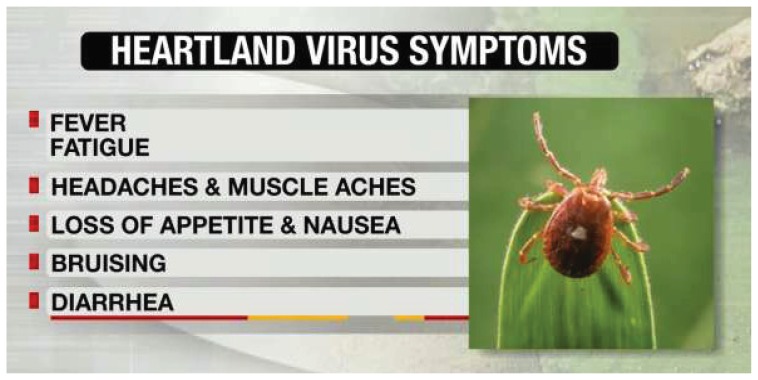In June 2009, two males ages 57 and 67 from Northwestern Missouri were hospitalized with symptoms consisting primarily of fever, fatigue, anorexia, and diarrhea. Prominent laboratory abnormalities included leucopenia with moderate neutropenia, thrombocytopenia, and elevated hepatic transaminase levels.1
They were both treated empirically with Doxycycline for suspected Ehrlichiosis, a common cause of febrile illness, leucopenia, thrombocytopenia and elevated hepatic transaminases in the warm weather months. Blood was drawn for PCR assay in both of them and sent to the CDC and was shown to be negative for Ehrlichia chaffeensis, Ehrlichia ewingii and rickettsiae of the spotted fever group and typhus.
Further work on the leukocytes of these two patients included inoculation into cultures of DH82 cells. These cultures showed cytopathic effects similar to those seen in E. chaffeensis, but there was no bacterial morulae. A virus was suspected as a possible etiologic organism and indeed electron microscopy findings revealed characteristics typical of a virus in the Bunyaviridae family. Additional genetic analysis proved that this virus is most similar to the phlebovirus in the Bunyaviridae family. Thus a newly discovered virus now named the Heartland virus is introduced.
In addition to the initial two index patients from Northwestern Missouri, six confirmed Heartland virus disease cases were identified in 2012–2013.2 Five patients were Missouri residents and one was a Tennessee resident. They were all men (ages 50–80). Symptoms were from May to September. All of them had fever, thrombocytopenia and leucopenia when first evaluated. All of them reported fatigue and anorexia and most reported headache, nausea, myalgia and arthralgia. Four of the five were hospitalized. One patient with multiple comorbidities died. All reported spending time outdoors and most of them reported tick bites in the two weeks prior to the illness.
Currently, a confirmed case of Heartland virus disease is defined as a clinically compatible illness in a person with laboratory evidence of recent Heartland virus infection. A clinically compatible illness is defined as fever (≥ 100.4 degrees F), leucopenia (WBC < 4,500 cells mm3) and thrombocytopenia (platelet count <150,000/mm3) without a more likely clinical explanation. Evidence of recent Heartland virus infection included:
detection of viral RNA by Reverse Transcriptase PCR on blood or tissue or
a ≥ 4 fold rise in virus-specific plaque reduction neutralization antibody titers between acute and convalescent serum specimens.
In field studies that were conducted it was shown that the Heartland virus is found in the Lone Star tick, Amblyoma americanum. As of this writing, this tick is considered the most likely vector of the Heartland virus.2
The Centers for Disease Control has worked with state and local officials to learn more about the virus. The MO Department of Health and Senior Services have been collaborating with the CDC on an epidemiologic investigation for Heartland virus in Missouri to better understand the role of the Heartland virus as a human pathogen. The investigation began in 2012 and patient enrollment ended in December 2015. Data analysis process has begun and the results will be published once the analysis is complete. Therefore, this review article contains data prior to the upcoming comprehensive study to be published.3
In summary, the Heartland virus is a novel virus first reported in Missouri in 2009. This virus can cause symptoms, clinical laboratory results and the occurrence of tick bite are similar to those of ehrlichiosis infections. The Heartland virus should be considered as a possible etiologic agent in instances particularly when suspected ehrlichiosis does not improve within a few days of Doxycycline treatment.
Biography
Eden M. Esguerra, MD, MSMA member since 1995 and Missouri Medicine Infectious Disease Editorial Board Member, is with Mercy Hospital in Joplin, Mo.
Contact: Eden.Esguerra@Mercy.Net

References
- 1.McMullan LK, Folk SM, Kelly AJ, et al. A new phlebovirus associated with severe febrile illness in Missouri. N Eng J Med. 2012;367:834–841. doi: 10.1056/NEJMMoa1203378. [DOI] [PubMed] [Google Scholar]
- 2.Pastula DM, Turabelidze G, et al. Notes from the field: Heartland Virus Disease – United States, 2012–2013”. MMWR Morbidity Mortality Weekly Report. 63(12):270–271. [PMC free article] [PubMed] [Google Scholar]
- 3.Baker Molly., MPH . Personal communication. Office of Veterinary Public Health, MO Department of Health and Senior Services; Zoonatic Disease Epidemiology Specialist. [Google Scholar]



